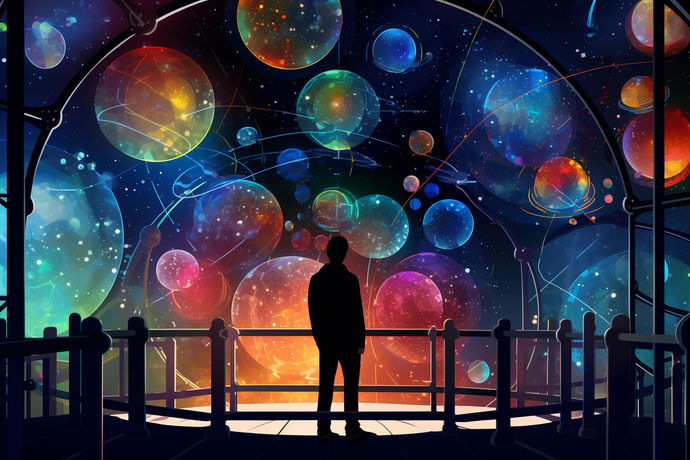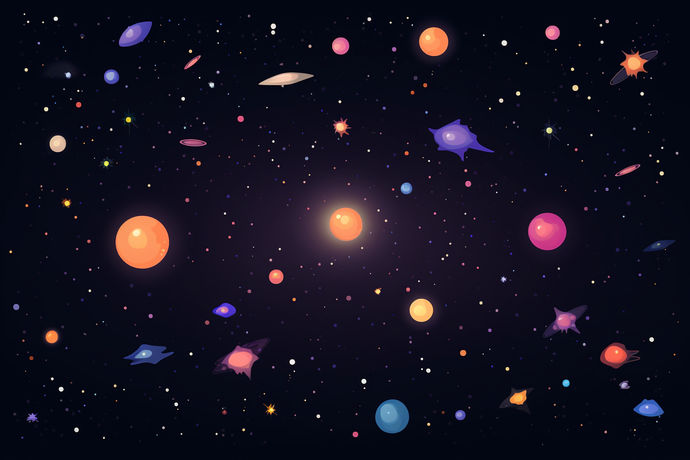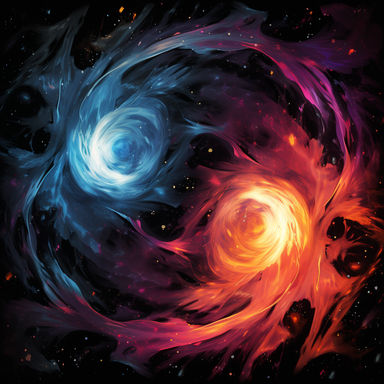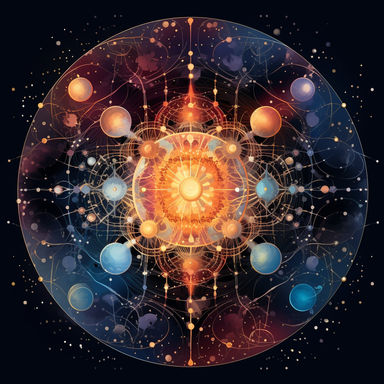Universe
Universe, approximately 13.8 billion years old, is a vast, ever-expanding space governed by four fundamental forces, originating from the Big Bang and largely composed of unseen dark matter and energy.
#TLDR
- The Universe, approximately 13.8 billion years old, is an ever-expanding space encompassing all known matter and energy, including galaxies, stars, and planets.
- Four fundamental forces - gravity, electromagnetism, and the strong and weak nuclear forces - govern the Universe, controlling all matter and energy interactions.
- The Universe is thought to have originated from a singularity in the Big Bang, triggering the expansion and evolution of space, time, matter, and energy.
- The Universe's structure is hierarchical, with planets orbiting stars in galaxies, galaxies forming groups and superclusters, separated by vast voids within the cosmic web.
- The Universe is also characterized by its dark matter and dark energy, unseen components that make up about 95% of the total content, influencing its expansion and structure.
- 💥Big Bang Theory: The Big Bang Theory is the prevailing cosmological model that explains the existence of the observable universe. It suggests that the universe began as a hot, dense point nearly 13.8 billion years ago. This theory is backed by multiple lines of empirical evidence, including the redshift of distant galaxies and the cosmic microwave background radiation.
- 🌌Cosmic Evolution: Cosmic evolution refers to the chronological sequence of events responsible for the formation of the universe, galaxies, stars, and planets. It encompasses the study of the physical, chemical, biological, and cultural changes that occur in the universe over time.
- 🌟Galaxies and Stars: Galaxies are vast cosmic entities composed of stars, gas, dust, and dark matter, bound together by gravity. Stars, the building blocks of galaxies, are celestial bodies made of hot gas that emit light and heat from the nuclear reactions at their cores.
- 🌑Dark Matter and Energy: Dark matter and dark energy are two mysterious components of the universe. Dark matter, which does not emit or interact with electromagnetic radiation, is thought to account for approximately 85% of the matter in the universe. Dark energy, on the other hand, is a hypothetical form of energy that permeates all of space and is believed to be the reason for the accelerating expansion of the universe.
- ⚛️Fundamental Forces: The universe is governed by four fundamental forces: gravity, electromagnetism, and the strong and weak nuclear forces. These forces are responsible for all interactions between particles and determine the behavior of all matter and energy within the universe.
- 🕸️Space-Time Fabric: Space-time is the four-dimensional framework in which the universe exists, combining three dimensions of space and one of time. The concept of the space-time fabric, often visualized as a trampoline-like surface, is used to explain the effects of gravity as distortions in this fabric caused by mass and energy.
- 📡Cosmic Microwave Background: The Cosmic Microwave Background (CMB) is the thermal radiation left over from the Big Bang. It provides a snapshot of the universe approximately 380,000 years after the Big Bang, and its discovery provided strong evidence for the Big Bang theory.
- 🔮Universe's Future Predictions: The future of the universe is a topic of significant scientific speculation. Some theories suggest it will continue to expand indefinitely, while others propose a cyclic model with repeated periods of expansion and contraction. The study of the universe's future is closely tied to understanding dark energy and the ultimate fate of galaxies, stars, and matter itself.

Interesting & Controversial
A scientist observing multiple universes through a telescope. (AI generated image)
- 🌌"Multiverse" Theory: The concept of a multiverse suggests that our universe might just be one of an infinite number of universes. This theory, while fascinating, is highly controversial as it currently lacks empirical evidence and is considered untestable by many scientists. However, if true, it could potentially explain many of the mysteries of our universe, such as the fine-tuning of physical constants.
- ⚛️Universe's Missing Antimatter: According to the Big Bang theory, equal amounts of matter and antimatter should have been created at the universe's inception. However, we observe a clear dominance of matter in the universe, leading to the "missing antimatter" problem. This discrepancy is one of the greatest unsolved mysteries in physics.
- 🌑Dark Matter Mystery: Despite making up about 85% of the universe's matter, dark matter remains one of the most enigmatic aspects of cosmology. It doesn't interact with light or any other form of electromagnetic radiation, making it incredibly difficult to detect. Its existence is inferred from its gravitational effects on visible matter, but its true nature remains unknown.
- 🧲The Great Attractor: The Great Attractor is a gravitational anomaly located about 220 million light-years away from us. It's pulling our galaxy, along with thousands of others, towards it at an incredible speed. The exact nature and cause of the Great Attractor remain a mystery due to the "Zone of Avoidance" - a region of space obscured by the Milky Way.
- 🔗Quantum Entanglement Enigma: Quantum entanglement, a phenomenon where particles become interconnected and the state of one can instantly affect the other, no matter the distance, challenges our understanding of the universe. This "spooky action at a distance," as Einstein called it, has been proven in experiments but still puzzles scientists with its implications for the nature of reality.
- 🎈Cosmic Inflation Debate: The theory of cosmic inflation proposes a period of extremely rapid expansion of the universe shortly after the Big Bang. While this theory explains several key observations, such as the uniformity of the Cosmic Microwave Background, it has also sparked debates due to its reliance on speculative physics and the difficulty in testing it empirically.
- 📏Universe's Shape Conundrum: Is the universe flat, spherical, or saddle-shaped? This question has puzzled cosmologists for decades. While most current data suggests a flat universe, recent studies of the Cosmic Microwave Background have hinted at a possible curvature, reigniting debates about the universe's true shape.
- 🌟"Oldest Star" Paradox: The star HD 140283, also known as the "Methuselah Star," appears to be older than the universe itself, based on its speed and composition. This paradox arises from uncertainties in age estimation methods. Resolving this paradox could lead to a better understanding of star formation and the early universe.

Interesting facts
The vast emptiness of the universe. (AI generated image)
- 🌌The universe is so vast that light from distant galaxies takes billions of years to reach us, meaning we're essentially looking back in time when we observe them.
- 🌠The Hubble Space Telescope has helped scientists estimate that there are around 100 billion galaxies in the universe.
- 🌟The largest known star, UY Scuti, is so big that if placed at the center of our solar system, it would engulf the orbit of Jupiter.
- 🌚The moon is moving away from Earth at an average rate of 1.5 inches per year due to the effects of gravity.
- 🌞Every second, the Sun converts 4 million tons of matter into energy.
- 🌀The Milky Way galaxy, where our solar system resides, is spinning at a speed of 168 miles per second.
- 🌈The universe is mostly made up of empty space, with stars and galaxies making up less than 5% of its mass.
- 🌌The universe is not only expanding, but the rate of its expansion is also accelerating due to dark energy.

Myth Busting
The Expanding Universe. (AI generated image)
- 🌌Myth: Edge of the Universe — The idea that the universe has an edge often stems from a misunderstanding of its expansion. In reality, the universe doesn't have a physical boundary. Instead, it's expanding into itself, and what we can observe is limited by the speed of light.
- 🌀Myth: Black Holes as Portals — While black holes are fascinating and complex cosmic phenomena, there's no scientific evidence to support the idea that they serve as portals to other dimensions or universes. They are regions of space where gravity is so strong that nothing, not even light, can escape.
- ∞️ Myth: Universe is Infinite — While the universe is incredibly vast and continually expanding, it's not necessarily infinite. The shape and extent of the universe are still topics of ongoing research in cosmology.
- 👽Myth: Aliens Built the Pyramids — Despite popular conspiracy theories, there's no credible evidence to suggest that extraterrestrial beings were involved in the construction of the pyramids. These remarkable structures are the result of human ingenuity and labor.
FAQ
How are galaxies formed?
Galaxies are formed through a process that involves the gravitational attraction of matter in the universe. Initially, small perturbations in the density of matter caused some regions to have slightly more matter than others. These regions then attracted more matter through gravity, eventually forming stars, galaxies, and clusters of galaxies.
What is the universe expanding into?
The universe is not expanding into anything; instead, it's the space itself that is expanding. This means that every point in the universe is moving away from every other point. It's a concept that defies our everyday understanding of how things move in space.
How is dark energy measured?
Dark energy is measured indirectly through its effects on the universe's expansion. Scientists observe distant supernovae, or exploding stars, to measure how fast the universe is expanding. The unexpected discovery that the expansion is accelerating led to the concept of dark energy.
Can antimatter be created?
Yes, antimatter can be created. In fact, it's regularly produced in particle accelerators for research purposes. When a high-energy particle collides with another, the energy of the collision can be converted into mass, creating a particle and its antiparticle.
What is inside a black hole?
The interior of a black hole, known as the singularity, is a point of infinite density according to general relativity. However, the laws of physics as we currently understand them can't describe what's inside a black hole. This is one of the biggest unsolved problems in theoretical physics.
How are cosmic distances calculated?
Cosmic distances are calculated using several methods. For nearby stars, astronomers use parallax, which is the apparent shift in a star's position as Earth orbits the Sun. For more distant stars and galaxies, they use standard candles, which are objects with known brightness, like certain types of supernovae or variable stars. The observed brightness of these objects can be used to calculate their distance.
"Two things are infinite: the universe and human stupidity; and I'm not sure about the universe."
Theoretical Physicist
Explore other sources
- 📖Book: "A Brief History of Time" — Written by renowned physicist Stephen Hawking, this book explores the nature of the universe, including the Big Bang, black holes, and the nature of time.
- 🎥YouTube Channel: "PBS Space Time" — This educational channel explores the outer reaches of space, the craziness of astrophysics, the possibilities of sci-fi, and anything else you can think of beyond Planet Earth.
- 🎞️Movie: "Interstellar" — Directed by Christopher Nolan, this film explores theoretical physics and cosmology through a thrilling narrative about space travel.
- 🌐Website: "NASA's Universe" — NASA's official website provides a wealth of information about the universe, including the latest news, research, and images from various space missions.
- 🎧Podcast: "StarTalk Radio" — Hosted by astrophysicist Neil deGrasse Tyson, this podcast blends pop culture with science to bring the universe down to Earth.
- 📖Book: "Cosmos" — Written by Carl Sagan, this book is a beautifully written exploration of the universe, from the smallest particles to the vastness of space.
- 🎥YouTube Channel: "Kurzgesagt – In a Nutshell" — This channel offers beautifully animated, easy-to-understand videos on complex topics, including many aspects of the universe.
- 🎧Podcast: "The Infinite Monkey Cage" — Hosted by physicist Brian Cox and comedian Robin Ince, this BBC radio show explores the wonders of science and the universe with a touch of humor.





